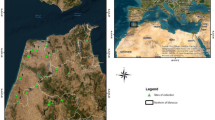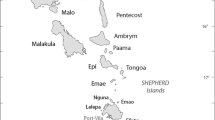Abstract
False indigo (Amorpha fruticosa L.) is a perennial leguminous shrub native to North America. The species could potentially be used for livestock forage, biomass energy, reclamation of degraded environments, or as green manure. Future work with the species will depend upon knowledge of available accessions. Our objectives were to determine (1) the range of diversity among accessions, (2) the correlations among traits across locations, and (3) the distribution of variation among accessions. We studied 21 accessions grown at two locations and a subset of 15 accessions grown at a third location. We measured 47 morphological, agronomic, and phenological traits. All traits were influenced by accession in at least one location (p < 0.05). The mean dry matter (DM) biomass yield of accessions in August ranged from 53 to 1515 g plant−1 and was correlated across locations. False indigo had a high second-year leaf concentration, averaging 660 g kg−1 DM at one location in August. Forage quality of false indigo leaves was high, with average crude protein (CP), acid detergent fiber (ADF), and neutral detergent fiber (NDF) concentrations in July of 205, 226, and 235 g kg−1, respectively. Accession means of forage quality traits were poorly correlated across locations, indicating that it would be difficult to improve forage quality through selection. Diversity among accessions was often related to geographic origin. The two southern accessions were distinct from all other accessions, indicating that accessions from distant geographic regions will likely contribute valuable diversity to a plant breeding program.
Similar content being viewed by others
References
A.B. Ainalis and C.N. Tsiouvaras, Forage production of woody fodder species and herbaceous vegetation in a silvopastoral system in northern Greece. Agrofor. Syst. 42 (1998) 1-11
O.N. Allen and E.K. Allen, The Leguminosae: A Source Book of Characteristics, Uses, and Nodulation. Madison, WI: University of Wisconsin Press (1981).
Official Methods of Analysis. Washington, DC: Association of Official Analytical Chemists (1985).
D.H. Bagisalup, D.K. Barnes and R.E. Stucker, Development of a core collection for perennial Medicago plant introductions. Crop Sci. 35 (1995) 1163-1168
C.H. Brett, Insecticidal properties of the indigobush (Amorpha fruticosa). J. Agric. Res. 73 (1946) 81-96
J.E. Brown, J.B. Maddox and W.E. Splittstoesser, Performance of trees, shrubs, and forbs seeded directly in the fall on minespoil and silt loam soil. J. Environ. Qual. 12 (1983) 523-525
Y.P Cao, G.J. Bai, G.Q. Wang and C.Y. Lu, Extraction and isolation of toxic constituents from the leaves of Amorpha fruticosa. J. Northwest Forestry College 11 (1996) 110-112
DeHaan L.R. 2001. Analysis of diversity among accessions of Amorpha fruticosa L. and Desmanthus illinoensis (Michx.) Macmillan. Ph.D. diss. University of MinnesotaSaint Paul (Diss. Abstr. AAT 3020586).
C. Dupraz, Fodder trees and shrubs in Mediterranean areas: browsing for the future?. In: V.P. Papanastasis (ed.) Proc. Int. Occasional Symp. of the European Grassland Federation, ThessalonikiGreece27–29 May 1999. ThessalonikiGreece: Hellenic Range and Pasture Society (1999) pp. 145-158
D. Ganskopp, T. Svejcar, F. Taylor, J. Farstvedt and K. Paintner, Seasonal cattle management in 3 to 5 year old bitterbrush stands. J. Range Manage. 52 (1999) 166-173
H.A. Gleason and A. Cronquist, Manual of Vascular Plants of Northeastern United States and adjacent Canada. Bronx, NY: The New York Botanical Garden (1991).
H.K. Goering and P.J. Van Soest, Forage Fiber Analyses (apparatus, reagents, procedures and some applications). Washington, DC: USDA Agric. Handb. 379. U.S. Gov. Print. Office (1970).
Flora of the Great Plains. LawrenceKS: University Press of Kansas (1986).
F.O. Holmes, Privets and Amorpha fruticosa as nectar sources. Glean. Bee Cult. 113 (1985) 79-80
T. Konoshima, H. Terada, M. Kokumai and M. Kozuka, Studies on inhibitors of skin tumor promotion, XII: Rotenoids from Amorpha fruticosa. J. Nat. Prod. 56 (1993) 843-848
C.S. Kuehn, H.G. Jung, J.G. Linn and N.P. Martin, Characteristics of alfalfa hay quality grades based on the relative feed value index. J. Prod. Agric. 12 (1999) 681-684
P.D. Lancashire, H. Bleiholder, T. den Boom, P. Langelü ddeke, R. Stauss, E. Weber and A. Witzenberger, A uniform decimal code for growth stages of crops and weeds. Ann. Appl. Biol. 119 (1991) 561-601
T. Lefroy, A tale of two alleys: parallel evolution in agroforestry. Agrofor. Today 6 (1994) 5-7
G.C. Marten, Summary of the trilateral workshop on persistence of forage legumes. In: R.F. Barnes (ed.) Forage legumes for energy efficient animal production. Washington, DC: USDA-ARS, U.S. Gov. Print. Office (1985) pp. 569-572
G.C. Marten, D.R. Buxton and R.F. Barnes, Feeding value (forage quality). In: A.A. Hanson (ed.) Alfalfa and Alfalfa Improvement. Madison, WI: Agron. Monogr. 29. ASACSSAand SSSA (1988) pp. 463-491
J.G. Mureithi, R.S. Taylor and W. Thorpe, Productivity of alley farming with leucaena (Leucaena leucocephala Lam. de Wit) and Napier grass (Pennisetum purpureum K. Schum.) in coastal lowland Kenya. Agrofor. Syst. 31 (1995) 59-78
E.J. Palmer, Conspectus of the genus Amorpha. J. Arnold Arboretum 12 (1931) 157-197
T.G. Papachristou and V.P. Papanastasis, Forage value of Mediterranean deciduous woody fodder species and its implication to management of silvo-pastoral systems for goats. Agrofor. Syst. 27 (1994) 269-282
T.G. Papachristou, P.D. Platis, V.P. Papanastasis and C.N. Tsiouvaras, Use of deciduous woody species as a diet supplement for goats grazing Mediterranean shrublands during the dry season. Anim. Feed Sci. Technol. 80 (1999) 267-279
V.P. Papanastasis, Grasslands and woody plants in Europe with special reference to Greece. In: V.P. Papanastasis (ed.) Proc. Int. Occasional Symp. of the European Grassland Federation, ThessalonikiGreece27–29 May 1999. ThessalonikiGreece: Hellenic Range and Pasture Society (1999) pp. 15-24
V.P. Papanastasis, P.D. Platis and O. Dini-Papanastasi, Effects of age and frequency of cutting on productivity of Mediterranean deciduous fodder tree and shrub plantations. For. Ecol. Manage. 110 (1998) 283-292
Z.M. Parissi and A.S. Nastis, Effect of drying method on forage quality determination of leguminous ligneous plants at different phenological stages. In: V.P. Papanastasis (ed.) Proc. Int. Occasional Symp. of the European Grassland Federation, ThessalonikiGreece27–29 May 1999. ThessalonikiGreece: Hellenic Range and Pasture Society (1999) pp. 397-401
Platis P. and Papanastasis V. 1993. Productivity of deciduous fodder trees and shrubs in relation to the year of cutting. In: Proc. FAO European sub-network on Mediterranean pastures and fodder crops, 7thChaniaCrete. 21–23 Apr. 1993. REUR technical series, FAO regional office for Europepp. 134–136.
F.J. Rohlf, NTSYSpc Numerical Taxonomy and Multivariate Analysis System Version 2.1. SetauketNY: Exeter Software (2000).
J.T. Romo, R.E. Redmann, B.L. Kowalenko and A.R. Nicholson, Growth of winterfat following defoliation in northern mixed prairie of Saskatchewan. J. Range Manage. 48 (1995) 240-245
W.B. Roth, M.E. Carr, I.M. Cull, B.S. Phillips and M.O. Bagby, Evaluation of 107 legumes for renewable sources of energy. Econ. Bot. 38 (1984) 358-364
M.D. Rumbaugh, D.A. Johnson and G.A. Van Epps, Forage yield and quality in a great basin shrubgrass, and legume pasture experiment. J. Range Manage. 35 (1982) 604-609
SAS User's Guide: Statistics. Cary, NC: SAS Inst (1990).
C.C. Sheaffer, D. Cash, N.J. Ehlke, J.C. Henning, J.G. Jewett, K.D. Johnson, M.A. Peterson, M. Smith, J.L. Hansen and D.R. Viands, Entry X environment interactions for alfalfa forage quality. Agron. J. 90 (1998) 774-780
C.C. Sheaffer, N.P. Martin, J.F.S. Lamb, G.R. Cuomo, J.G. Jewett and S.R. Quering, Leaf and stem properties of alfalfa entries. Agron. J. 92 (2000) 733-739
B.J. Simpson, B.W. Hipp and E.L. McWilliams, Dark Lance false indigo. HortScience 24 (1989) 713-714
Szabó A.T. 2005. Plants pouring Hungary. Hungarian Studies on Biological Invasions. BioTar Electronic, Amplicon Book Reviews. [Online] http://binet.biotar.vein.hu.
Cs. Sziegetvari, Initial steps in the regeneration of a floodplain meadow after a decade of dominance of an invasive transformer shrubAmorpha fruticosa L. Tiscia 33 (2002) 67-77
Minnesota Vascular Plant Database [Online Database]. Minneapolis, MN: J. F. Bell Museum of Natural History Herbarium (2001).
National Genetic Resources Program. Germplasm Resources Information Network – (GRIN) [Online Database]. BeltsvilleMD: National Germplasm Resources Laboratory (2001).
USDA NRCS. 2004. The PLANTS Database, Version 3.5 (http://plants.usda.gov). National Plant Data Center, Baton
E.T. Wang, P. van Berkum, X.H. Sui, D. Beyene, W.X. Chen and E. Martinez-Romero, Diversity of rhizobia associated with Amorpha fruticosa isolated from Chinese soils and description of Mesorhizobium amorphae sp. nov. Int. J. Syst. Bacteriol. 49 (1999) 51-65
R.L. Wilbur, A revision of the North American genus Amorpha (Leguminosae-Psoraleae). Rhodora 77 (1975) 337-409
Wright J. and Bergsrud F. 1991. Irrigation Scheduling: Checkbook Method. AG-FO-1322-G. Minn. Ext. Serv., St. Paul.
Author information
Authors and Affiliations
Corresponding author
Rights and permissions
About this article
Cite this article
DeHaan, L., Ehlke, N., Sheaffer, C. et al. Evaluation of Diversity among North American Accessions of False Indigo (Amorpha fruticosa L.) for Forage and Biomass. Genet Resour Crop Evol 53, 1463–1476 (2006). https://doi.org/10.1007/s10722-005-6845-6
Received:
Accepted:
Published:
Issue Date:
DOI: https://doi.org/10.1007/s10722-005-6845-6




